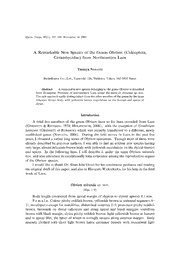
A Remarkable New Species of the Genus Obrium (Coleoptera, Cerambycidae) from Northeastern Laos PDF
Preview A Remarkable New Species of the Genus Obrium (Coleoptera, Cerambycidae) from Northeastern Laos
Elytra,Tokyo,37(2):355(cid:1)359,November14,2009 A Remarkable New Species of the Genus Obrium (Coleoptera, Cerambycidae) from Northeastern Laos Tatsuya NIISATO BioindicatorCo.,Ltd.,Yarai-chˆo126,Shinjuku,Tokyo,162(cid:1)0805Japan Abstract AremarkablenewspeciesbelongingtothegenusObriumisdescribed from Houaphan Province of northeastern Laos under the name O. miranda sp. nov. Thenewspeciesiseasilydistinguishedfromtheothermemberofthegenusbythelarge infuscate brown body with yellowish brown maculation on the humeri and apices of elytra. Introduction A total five members of the genus Obrium have so far been recorded from Laos (GG:HH>II & RDC9DC, 1970; HDAOH8=J=, 2008(cid:1)(cid:2) with the exception of Uenobrium laosicum (GG:HH>II et RDC9DC) which was recently transferred to a di#erent, newly established genus (N>>H6ID, 2006). During the field survey in Laos in the past five years,IobtainedaratherlongseriesofObriumspecimens. Thoughmostofthemwere alreadydescribedbypreviousauthors,Iwasable to find an evident new species having verylarge,almostinfuscatebrownbodywithyellowishmaculationontheelytralhumeri and apices. In the following lines, I will describe it under the name Obrium miranda nov.andalsointroduceitsexceptionallylongovipositoramongthereproductiveorgans of the Obrium species. IwouldliketothankDr.Shun-IchiU´:CDforhiscontinuousguidanceandreading theoriginaldraftofthispaper,andalsotoHiroyukiW6@6=6G6forhishelpinthefield work of Laos. Obrium miranda sp. nov. (Figs.1(cid:1)5) Body length (measured from apical margin of clypeus to elytral apices) 9.1mm. Female. Colourpitchyreddishbrown,yellowishbrowninantennalsegments4(cid:1) 11,mouthpartsexceptformandibles,abdominalventrites2(cid:1)5;pronotumpitchyreddish brown, brownish on discal callosities and along apical and basal margins; scutellum brownwithblackmargin;elytrapitchyreddishbrown,lightyellowishbrownathumeri and in apical fifth, the latter of which is strongly sinuate along anterior margin. Body sparsely clothed with short light brown hairs; antennae densely with recumbent light 356 TatsuyaN>>H6ID brown hairs on basal four segments, sparsely so on segment 5; pronotum only sparsely with long erect light brown hairs; elytra uniformly with short light brown hairs throughout; ventral surface sparsely covered with short pale hairs, except for silvery pubescent mesosternum and middle of prosternum. Headlargeincludingwellexpandedeyes,1.15timesaswideasthemaximumwidth ofpronotum,almostsmooth,scatteredwithafewpunctures;frons3.3timesaswideas long, strongly declivous to a deep median groove, fronto-clypeal suture transverse semicircular, markedly deep; clypeus trapezoidal, 3/5 the length of basal width, with a few punctures; mandibles stout, rather long, hooked near apices; maxillary palpus elongate,arcuatelydilatedtobasalhalfthengentlynarrowedapicad,twicethelengthof theprecedingsegment;vertexflattened;eyesindorsalviewseparatedfromoneanother by 1/5 the width of occiput or 7/20 the width of each lobe. Antennae very long, filiform, stout, 1.6 times as long as body, exceeding elytral apices at base of segment 8, roughonsurfaceofbasal four segments, shagreened in the remainders; scape elongate, slightlyclavate,1.35timesaslongassegment3,segment5thelongest,1.25timesaslong as segment 3, terminal segment hardly arcuate. Pronotum relatively long, slightly divergent apicad, narrow, a little longer than wide, 1.40 times as long as the apical width, a little shorter than half the length or 4/5 the width of elytra; apical margin arcuately produced; basal margin gently emarginate; disc moderately convex, provided with a pair of rounded callosities at sides of apical third and a similar median one behind middle, very sparsely scattered with medium- sized punctures. Scutellum very narrow, longitudinally quadrate. Elytra nearly 2.4 times as long as the humeral width, broad, widest at apical third which is 1.15 times as wide as humeri; sides with oblique humeri, gently arcuately emarginate to middle, then moderately arcuate to completely rounded apices; disc distinctly raised near suture of basal fifth and apical fourth, depressed on middle near suture, sparsely provided with fine punctures in irregular rows, which become sparser near apices. Venterofthoracessparselyscatteredwithfinepuncturesandshorthairs,exceptfor mesosternum and middle of prosternum which have coarse punctures and slivery pubescence; metepisternum provided with a deep longitudinal groove in almost entire length. Abdomenbroad,wellconvex;basalventritelarge,3/7oftheentirelength,finely sparsely punctured; 2nd ventrite with rake-shaped organ more or less reduced, 2/5 the widthof2ndventrite;analventriteobtusetriangular,clothedwithlongsetaenearapical margin. Legsmoderateinlength,ratherthin,coarselyroughon surface of tibiae and tarsi, with hind femur moderately clavate and compressed in apical 2/5, 1st hind tarsal segment 1.3 times as long as the following two segments combined. Female genitalia. Paraproct and coxite weakly conjoined, consisting of a long piece, with thin baculi straight in the former though oblique in the latter; coxite lobe weakly sclerotized, rather short, rounded at apex, provided with long setae near apex and short ones at sides; stylus moderately sclerotized, slightly thickened apicad, ANewObriumfromNortheasternLaos 357 Fig.1. Obrium miranda sp. nov., holotype (cid:1), from Phou Pan (Mt.), Houaphan Province of northeasternLaos. withfourlongsetaeatapex;spermatheca distinctly sclerotized, long, almost U-shaped, with large gland which is constricted in basal part. Type specimen. Holotype (cid:1), Phou Pan (Mt.), Houaphan Prov. of NE. Laos, 16(cid:1) IV(cid:1)15(cid:1)V(cid:1)2004,nativecollectorleg.TheholotypeispreservedintheNationalMuseum of Nature and Science, Tokyo. Distribution. Laos. Notes. Obriummirandasp.nov.isaverypeculiarspeciesinhavinglargeinfuscate brownish body with yellowish brown maculation at humeri and in apices of elytra. It hasnocloserelativeamongthemembersofthegenus. Thisnewspeciesmayhavesome relatiopnshipwithO.posticumposticumG6=6C(1894,p.14)and O. p. saigonense P>8 (1933, p. 9), but is clearly distinguished from them by the unique coloration and 358 TatsuyaN>>H6ID Figs.2(cid:2)5. Female abdomen and genital segments of Obrium miranda sp. nov., from Phou Pan (Mt.), Houaphan Province of northeastern Laos.(cid:1)(cid:1)2,Abdominalventrites, omittedfine hairs; 3,ovipositorandtergite8;4,sternite8;5,spermatheca. structures of pronotum which has three distinct callosities instead of being almost smooth. OnlythefemaleholotypeexaminedwascollectedbynativecollectorofBanSaleui, foot of Phou Pan (Mt.). (cid:1) (cid:2) (cid:1)(cid:2)(cid:3)(cid:4)(cid:5)(cid:6)(cid:7)(cid:8)(cid:9)(cid:10)(cid:11)(cid:12)(cid:13)(cid:14)(cid:15)(cid:16)(cid:17)(cid:18)(cid:19)(cid:20)(cid:21)(cid:22)(cid:23)(cid:24)(cid:25)(cid:26)(cid:27)(cid:21)(cid:28)(cid:29)(cid:30)(cid:31) !"1(cid:1)#$(cid:1)(cid:1) (cid:6) (cid:7)(cid:8)(cid:12)(cid:13)%(cid:17)&’(5#(cid:31)(cid:19)(cid:20)(cid:21)(cid:22)(cid:23)(cid:24)(cid:25)(cid:26)(cid:27)(cid:21)(cid:28)(cid:29)(cid:30))*+(cid:16)(cid:17),-.)/ 0(cid:31)124#&’ )345,67("8,(cid:14)(cid:15)(cid:16)(cid:17)(cid:18)9(cid:31)’:.$ ;(cid:18)2(cid:31)<=(cid:31)>?’9@A(cid:31)B(cid:30)(cid:31)CB)D (cid:13)(cid:17),-.)/0(cid:31)"(cid:12)((cid:15)E(cid:16)(cid:17)(cid:18)F1G(cid:31)HIJK/345,LM’(cid:12)NOP"QRS92/ B(cid:30)(cid:31)-T(cid:17)(cid:31)UV#(9WXY"-$ 0%’BZ[’Obriummirandasp.nov.\-1(cid:1)]S^ _,*‘Y(cid:18)$ B(cid:1)#K<(cid:30)a(bc(cid:31)defgSh5(cid:13)(cid:17).9(cid:31)K"-)/ ijK&8(cid:18)kl ANewObriumfromNortheasternLaos 359 (cid:1)(cid:2)(cid:3)(cid:4)(cid:4)(cid:5) (cid:6)(cid:7)(cid:8)(cid:9)(cid:10)(cid:11)(cid:12)(cid:13)(cid:14)(cid:15)(cid:16)(cid:17)(cid:2)O. posticum P>8(cid:12)(cid:18)(cid:19)(cid:20)(cid:21)(cid:21)(cid:22)(cid:23)(cid:24)(cid:2)(cid:25)(cid:26)(cid:27)(cid:3)(cid:28)(cid:2)(cid:29) (cid:30)(cid:31)(cid:5) O.mirandasp.nov(cid:29) (cid:4) !"#$(cid:11)%&’((cid:7))*%+,-(cid:12)(cid:28).(cid:23)#/0(cid:12)1(cid:14)234 (cid:23)56789(cid:23):;<(cid:28)(cid:2)(cid:29) References G6=6C,C.J.,1894.AlistofthelongicornColeopteracollectedbySignorF:6inBurmaandtheadjoining regions,withdescriptionsofthenewgeneraandspecies.Annli.Mus.civ.Genova,34:5(cid:1)104,pl.1. GG:HH>II,J.L.,&J.A.RDC9DC,1970.CerambycidsofLaos.(Disteniidae,Prioninae,Philinae,Aseminae, Lepturinae,Cerambycinae).Pacif.Ins.Mon.,24:1(cid:1)314. HDAOH8=J=, C., 2008. Beschreibung von 60 neuen Bockk¨afern undeiner neuenGattungausderoriental- ischenRegion,vorwiegendausLaosundBorneo(Coleoptera,Cerambycidae).Ent.Basil.,30:149(cid:1)241. N>>H6ID,T.,2006.AnewobriinegenusUenobrium(Coleoptera,Cerambycidae)anditscomponents.Elytra, Tokyo,34:207(cid:1)221. P>8,M.,1933.Nouveaut´esdiverses.Mel.Exot.-Ent.,(61):3(cid:1)36. Elytra,Tokyo,37(2):359(cid:1)360,November14,2009 New Distributional Record of Cercyon (Cercyon) aptus (Coleoptera, Hydrophilidae) from the Island of Iriomote-jima, the Ryukyus, Japan Masahiro«OHARA1) and Yasuko KAWAKAMI2) 1) TheHokkaidoUniversityMuseum,HokkaidoUniversity, N10W8,Sapporo,060(cid:1)0810Japan 2) 2(cid:1)30(cid:1)9,Kotobuki-chˆo,Takatsuki,569(cid:1)0826Japan Cercyon (Cercyon) aptus was described from Honshu and Kyushu (S=6GE, 1873)(cid:5) and is rather common under seaweeds on sandy beaches and widely distributed throughout Japan. Recently,thespecieshasbeenadditionallyrecordedfromPrimorskyKray,theKurilIslands,and peripheral Islandso#Hokkaido,Japan (S=6IGDKH@>N,1989,1992,«O=6G6 andJ>6,2006,and «O=6G6, 2008). Under a series of faunal researches of the supralittoral insects ofthe Islandof Iriomote-jima, we have had the opportunity to examine several specimens collected under seaweedsonsandybeaches. ThisisthefirstrecordofthespeciesfromtheRyukyus. We thank Messrs.T.W696andS.S=>N6@:(OsakaMuseumofNaturalHistory,Japan)whoprovidedus 360 Masahiro«O=6G6andYasukoK6L6@6B> valuable specimens. Cercyon (Cercyon) aptus S=6GE, 1873 CercyonaptusS=6GE,1873,65[Japan(Kyushu:Nagasaki,Honshu:Hyogo)];K>AH,1999,177[Hokkaido]. Cercyon(Cercyon)aptus:S=6IGDKH@>N,1989,281[southernKurils,PrimorskyKray];«O=6G6&J>6,2006, 131[redescription,key;Kurils]. Cercyon (Cycreon) aptus: S=6IGDKH@>N, 1992, 367 [designation of lectotype (Japan, female); southern Kurils]. Cercyonsp.2:K6L6@6B>,2000,7[Iriomote-jima]. Specimensexamined. [Iriomote-jima,theRyukyus,Japan]1ex.,Sonai-no-hama,8(cid:1)V(cid:1)1999, T.W696leg.,housedintheOsakaMuseumofNaturalHistory.2malesand2exs.,Hoshizuna- no-hama,Uehara, 24(cid:1)26(cid:2)11(cid:3)N123(cid:1)40(cid:2)38(cid:3)E,4(cid:1)XII(cid:1)2008,M.«O=6G6leg. (IR-08-MO-040). References K6L6@6B>, Y., 2000. List of marine Coleoptera from Yaeyama Islands, the Ryukyus,Japan.Nejirebane, Osaka,(89):7(cid:1)9. (InJapanese.) KushiroInsectLover’sSociety(KILS),1999.Chapter6.AlistofInsectsoftheNemuropeninsula.InKILS (ed.),InsectoftheNemuropeninsula.Sylvicola,supplement,3:143(cid:1)318.(InJapanese,withEnglishtitle andsummary.) «O=6G6,M.,2008.NewrecordsofthesupralittoralspeciesofthegenusCercyon(Coleoptera,Hydrophilidae) fromtheperipheralislandso#Hokkaido,Japan.Elytra,Tokyo,36:343(cid:1)348. (cid:2)(cid:2)(cid:2)(cid:2)&F.J>6,2006.TerrestrialHydrophilidbeetlesoftheKurilArchipelago(Coleoptera,Hydrophili- dae). BiodiverstiyandbiogeographyoftheKurilIslandsandSakhalin,2:129(cid:1)150. S=6GE,D.,1873.ThewaterbeetlesofJapan.Trans.ent.Soc.London,1873:45(cid:1)67. S=6IGDKH@>N[as“S=6IGDKH@>?”],A.G.,1989.Hydraenidae,Hydrophilidae(pp.260(cid:1)293).InL:G,P.A. (ed.),Opredelitel‘nasekomykhDal’negoVostokaSSSRvshestitomakh,3.Zhestkokrylye,ilizhuki(part 1).572pp.Nauka,Leningrad. S=6IGDKH@>N [as “S=6IGDKH@>?”], A. G., 1992. Novye i maloizvestnye vodolyubovye (Coleoptera, Hydrophiloidea)izyuzhnogoPrimor’yaisopredel’iykhterritorii.(NewandlittleknownHydrophiloidea (Coleoptera)fromsouthernPrimoryeterritoryandadjacentregions).Ent.Obozr.,71:359(cid:1)371.
